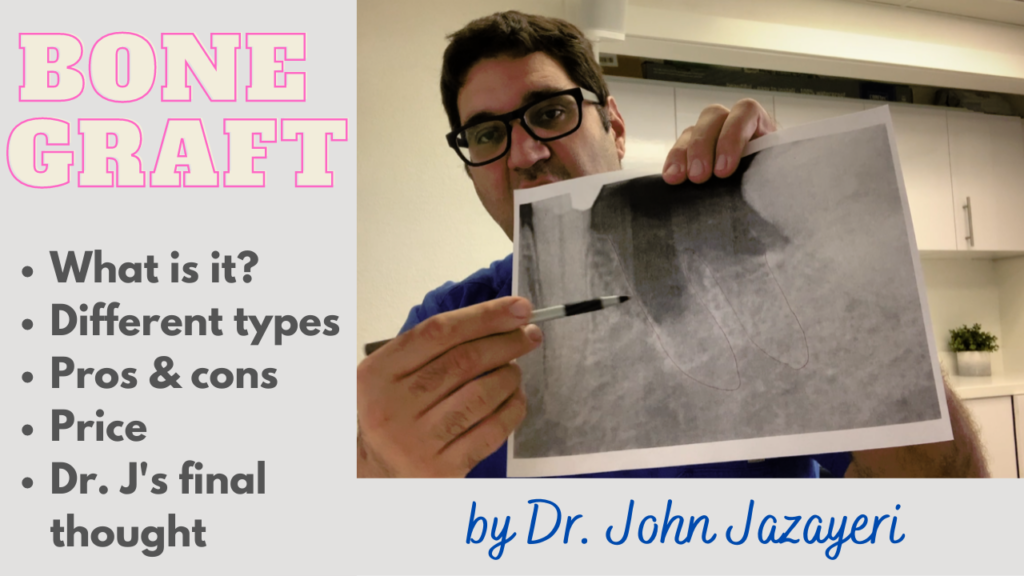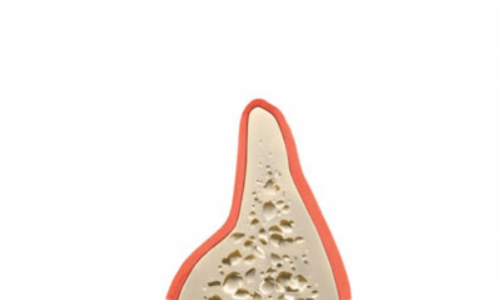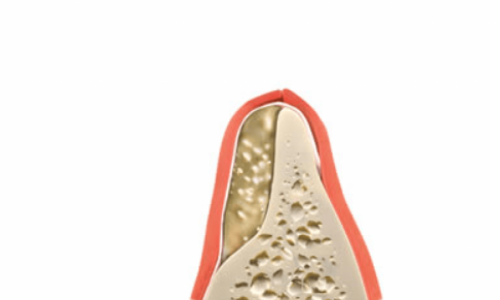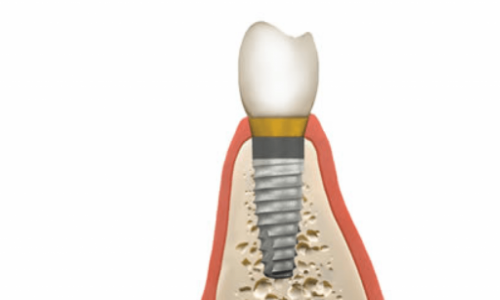What is a bone graft?
Bone graft is a bone substitute that dentists use to restore and preserve the jawbone. Bone graft is primarily used during tooth extraction for socket preservation. It is also oftentimes used to assist with dental implant surgery. Placing a bone graft assists your body in growing more of its own bone. Essentially, the bone graft acts as a space maintainer to fill in the tooth extraction socket. This allows your body to regenerate more bone and heal more predictably.
What is the purpose of bone grafting?
Bone graft has several functions. It assists your body in healing better after tooth extraction. It also helps preserve more jawbone. Whenever you lose a tooth, the jawbone starts to shrink at an accelerated rate. Placing a bone graft after tooth extraction preserves more jawbone. This is especially important if you're planning on placing a dental implant in place of the missing tooth. In order for dental implants to succeed, they must be placed in solid bone structures. Oftentimes, the ideal position for placing a dental implant lacks sufficient bone to fully secure the implant post. In these situations, your dentist has to add some bone graft to prepare the jawbone for successful implant placement.
Where do bone grafts come from?

Bone graft may be synthetic, animal-based, cadaver sourced, or come from your own body
There are several different sources of bone grafts. Each type of bone graft has its own implications in dentistry. Here is a list of the most common types of bone graft material used in implant dentistry:
Synthetic Bone Grafts
Synthetic bone grafts are probably the most commonly used type of grafting material. These grafts are cost-effective, safe, and perfect for restoring minor bony defects. Synthetic bone graft is made from material that closely resembles bone particles including calcium apatite and calcium phosphate. The graft fills in small defects to allow for additional bone growth within the region.
Allografts
Allograft is bone graft material that comes from a cadaver or an animal donor. These grafts include bovine bone (from cows), xenograft bone (from pigs), and human cadaver bone. Allograft bone does not get absorbed as quickly as synthetic bone does. This makes allograft bone a better option for preserving larger bony defects where the graft needs to last for a longer period of time.
Autogenous Bone Grafts
An autogenous bone graft is any bone graft that comes from your own body. In other words, you're the donor as well as the recipient. Your implant dentist or oral surgeon will harvest bone from a donor site and use that same bone to repair the bony defect. Common oral donor sites include the ramus of the mandible and the chin. For more complex cases, your dentist may have to harvest bone from the hip, the leg, or even the rib cage. As you'd imagine, autogenous bone grafting is reserved for the most extensive bony defects with no alternative options.
Regardless of the source, bone graft helps your body regenerate more of its own natural bone. As you deposit more bone tissue the body gradually absorbs and replaces most or all of the graft with natural bone. Once you've developed enough solid bone, your dentist can now secure your dental implants and restore your missing teeth.
When do you need sinus grafting?
Sinus grafting is often times required when placing dental implants in the upper posterior region. Your dentist will examine your jawbone using a CT scan to evaluate how much bone you have underneath the sinus. If you don't have enough bone structure, then a sinus graft procedure is necessary. The type of grafting depends on where the implant is being placed and how much bone there is under the sinus.
What is a sinus lift or sinus graft?
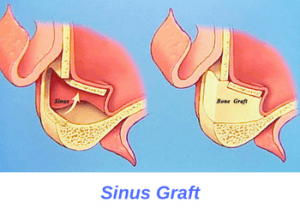
Sinus lift restores the bone below your sinuses to allow for implant placement in the upper back region
Sinus lift or sinus graft is another grafting procedure. It is performed whenever there's insufficient bone to place dental implants in the upper posterior regions. For those of you with a knowledge of teeth numbers, this includes teeth #2, 3, 4, 13, 14, 15, and less commonly teeth #5 and 12. The upper posterior region typically lacks sufficient bone due to its proximity to the maxillary sinus. This creates a challenge when trying to place dental implants in these regions. In order to restore your bone, a sinus lift or sinus graft must be performed. Here's how these sinus grafting procedures work:
Sinus Lift
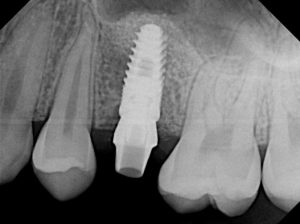
During a sinus lift, your dentist pushes the sinus membrane up by a few millimeters
A sinus lift is indicated whenever you have some jawbone under the sinuses but not enough to place a dental implant. This is usually the case when you have between four to six millimeters of jawbone under the sinus membrane. This amount of jawbone is not enough to secure dental implants. As a result, your dentist needs to push the sinus membrane up to place the implant post. Your dentist will push and lift the sinus membrane upward and pack some bone graft underneath it. This creates the additional room required to place a dental implant post. Oftentimes, the dental implant and sinus lift are performed during the same surgery. But what happens if you don't perform the sinus lift? Well, the implant can damage and cause an infection of the sinus. Worse case, the implant will accidentally drop into the sinuses and you will require a sinusecotomy to remove the trapped implant!
Lateral Wall Sinus Graft
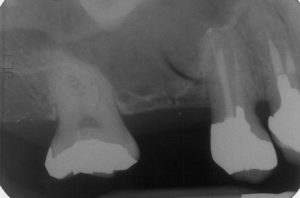
A lateral wall sinus graft is required whenever you have less than 2 to 3 millimeters of bone underneath the sinus
A lateral wall sinus graft is a more complex surgical procedure than a sinus lift. This surgery is reserved for cases with almost no bone underneath the sinus membranes. You require a lateral wall sinus graft whenever you have less than 2 to 3 millimeters of bone under the sinus membrane. A sinus lift alone can not restore sufficient bone for implant placement under these circumstances. Instead, you must perform a lateral wall sinus graft procedure. First, your dentist will create an opening in your upper jaw using a lateral wall approach. Next, your dentist will gently separate and lift the sinus membrane. Through this opening, your dentist will gradually add a substantial amount of bone graft. Be sure to carefully follow your dentist's post-operative instructions. This includes avoiding putting any pressure on the sinuses for the next week or two. It typically takes six months for the sinus to grow sufficient bone after surgery. You're now ready to receive your dental implants without having to worry about the sinuses.
Bone graft procedure in San Clemente, Orange County

We offer all phases of grafting treatments including sinus lifts, sinus grafts, and bone grafts
You may have been told that you can not receive dental implants because you don't have enough jawbone. This is usually not true, as almost everyone is a candidate nowadays. Give us a call if you're looking for bone grafting or dental implant treatment. Schedule your consultation by calling (949)481-2540 or book your implant consult online. Dr. Jazayeri performs sinus lifts, sinus grafts, and all sorts of bone grafting procedures. We are located in San Clemente, Orange County. Don't delay treatment any longer! Fill out the form below to schedule your dental appointment today:
To learn more about different implant-related treatments, click on the links below:
